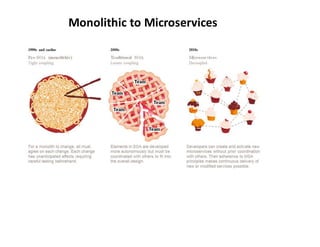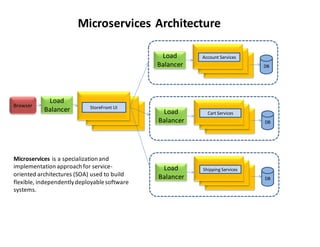Monolithic to Microservices Architecture
- 2. Browser Load Balancer Data Access Service Shipping Services StoreFront UI Account Services Cart Services DB Monolithic Architecture Monolithic architecture is the traditional unified model for the design of a software program.Monolithic software is designed to be self-contained; components of the program are interconnected and interdependent rather than loosely coupled as is the case with modular software programs.
- 3. Browser Load Balancer StoreFront UI Account ServicesLoad Balancer DB Cart ServicesLoad Balancer DB Shipping ServicesLoad Balancer DB Microservices Architecture Microservices is a specialization and implementation approach for service- oriented architectures (SOA) used to build flexible, independentlydeployablesoftware systems.
- 4. Comparison Monolithic • Simple full deployments • Inter-module refactoring • Binary failure modes • Symmetric Scaling • Technology monoculture Microservices • Partial deployments • Strong module boundaries • Graceful degradation • Asymmetric scaling • Technical diversity • Testing is complex
- 5. Virtual Machines and Containers Virtual machines include the application, the necessary binaries and libraries, and an entire guest operating system -- all of which can amount to tens of GBs. Containers include the application and all of its dependencies --but share the kernel with other containers, runningas isolated processes in user space on the host operating system.
- 6. Container Advantages • Rapid Development – Containers include the run-time requirements of the application • Portability - Servers/Cloud • Lightweight Foot Print – Size, Resources • Sharing and Collaboration of Images – Docker Hub • Application Isolation – Run in own space Container Challenges • Resource and State Management – What happens if a host has a trouble? – How to keep them running? – How to manage multiple hosts? • Data and Network Management – Volumes – Subnets • Monitoring – Identify container failures • Service Discovery – How to avoid port conflicts? • Deployment – Co-ordination among multiple services
- 7. Refactoring to Microservices • Strategy 1 – Stop Digging – The Law of Holes says that whenever you are in a hole you should stop digging. This means that when you are implementing new functionality you should not add more code to the monolith. Instead, the big idea with this strategy is to put that new code in a standalonemicroservice. • Strategy 2 – Split Frontend and Backend – A strategy that shrinks the monolithic application is to split the presentation layer from the business logic and data access layers. – Instead of packaging all of your related WARs in one EAR, split them up into independentWARs • Strategy 3 – Extract Services – A large, complex monolithic application consists of tens or hundreds of modules, all of which are candidates for extraction. – Existing REST/JMS/SOAP/EJB services – Simple Servlet/JSP interfaces • Strategy 4 – Data Services – Isolated islands of data, De-normalize
- 8. Container Software • Docker • CoreOS Rocket • Canonical LXD • Spoonium • Flockport • Solaris Zones (2004) Cloud Providers • Amazon Web Services • Microsoft Azure • Digital Ocean • Exoscale • Google Compute Engine • OpenStack • Rackspace • IBM Softlayer
- 9. • Etcd o Service discovery / Globally distributed key-value store • Consul o Service discovery / Globally distributed key-value store • Zookeeper o Service discovery / Globally distributed key-value store • Crypt o Project to encrypt etcd entries • Confd o Watches key-value store for changes and triggers reconfiguration of services with new values Service Discovery Tools
- 10. • Flannel o Overlay network providing each host with a separate subnet. • Weave o Overlay network portraying all containers on a single network. • Pipework o Advanced networking toolkit for arbitrarily advanced networking configurations. Docker Networking Tools • Dynatrace o High level metrics • Datadog o Monitor infrastructure, track metrics, events • SignalFx o Real time analysis with low latency • Sysdig o Monitoring microservices, sits at OS level • New Relic o Application and server centric Monitoring Tools
- 11. • AWS ECS o Scheduler and Cluster Management • Fleet o Scheduler and Cluster management tool. • Marathon o Scheduler and Service management tool. • Docker Swarm o Scheduler and Service management tool. • Mesos o Host abstraction service that consolidates host resources for the scheduler. • Kubernetes o Advanced scheduler capable of managing container groups. • Compose o Container orchestration tool for creating container groups. Container Management Tools
- 12. Release Processes Levels Source Build Test Production Continuous integration Continuous delivery Continuous deployment
- 13. Code Pipeline Continuous Delivery Code Deploy Cloud Formation OpsWork Continuous Integration Code Commit SVN Continuous Development Code Build Configuration Management DevOps Tools
- 14. AWS ECS Infrastructure Management • Monitoring and Logging ➢ Cloudwatch ➢ CloudWatch Logs (S3, Kinesis, Lambda, Elastisearch) • AutoScaling ➢ CloudWatch Alarm on a metric (MemoryReservation) ➢ Scaling policies to increase/decrease • Service Discovery ➢ ELB, Route 53 DNS • Security ➢ IAM Roles for ECS Tasks ➢ Logging with CloudTrail
- 15. DevOps Borat @DEVOPS_BORAT To make error is human. To propagate error to all servers in automatic way is #devops.














